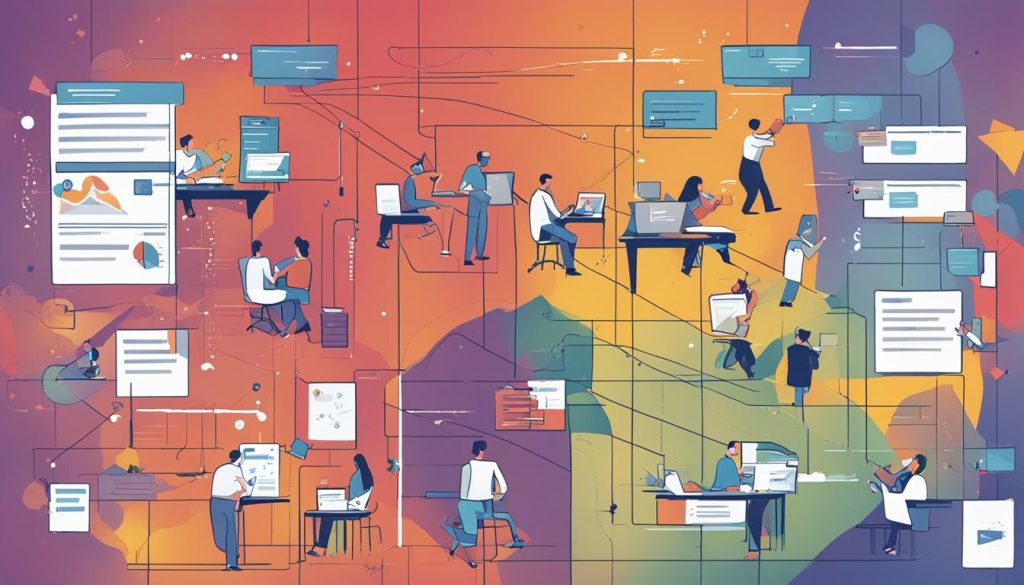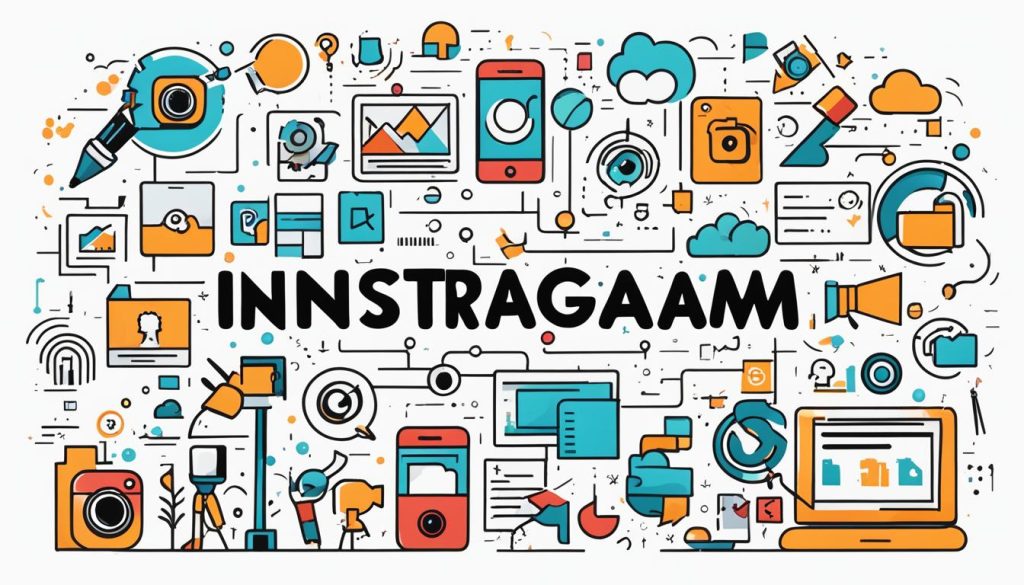At Grew Studio, we understand that gathering feedback on prototypes is a cornerstone of the design thinking and human-centred design processes. Acquiring this feedback deliberately and meticulously is essential for garnering deep insights that drive innovation and efficiency. Our CEO, Adam Oliver Kollar, is committed to an optimised approach that ensures effective prototype usability testing and insightful design iteration feedback, saving both time and resource.
Key Takeaways
- Engage in purposive feedback collection to obtain valuable insights that inform design iterations.
- Implement efficient strategies for prototype usability testing.
- Foster a feedback-driven development culture to enhance product functionality and user satisfaction.
- Utilise feedback to refine prototypes based on actual user interactions and experiences.
- Embrace feedback as a tool for resource optimisation during the design process.
The Importance of Prototype Feedback in Design Thinking
In our ongoing pursuit of excellence in design, we at Grew Studio recognise the pivotal role of user feedback on prototypes within the expansive realm of design thinking. It’s this very feedback that empowers us to persistently finetune our creations, ensuring every aspect resonates with the user’s needs and expectations. The value of such feedback cannot be overstated, as it lays the foundation for feedback for design improvements and integrates seamlessly with the feedback in agile methodology which we adhere to.
- Feedback serves as a beacon, guiding our iterative design process towards more intuitive and user-friendly experiences.
- It acts as a barometer for user satisfaction, helping to enhance the usability and aesthetic appeal of our prototypes.
- With each iteration, we rely on feedback to propel us further along the path of innovation and excellence.
| Stage of Design Thinking | Focus of Feedback | Outcome |
|---|---|---|
| Empathise | User needs and pain points | Deeper understanding of the user |
| Define | Problem identification | Clear design objectives |
| Ideate | Creativity and solution generation | Innovative concepts to explore |
| Prototype | Usability and functionality | Refined design ready for testing |
| Test | User experience and satisfaction | Actionable insights for final design |
As our methodology is deeply rooted in agile principles, feedback is not merely a checkpoint but is integral to our everyday hustle. It instigates critical assessment and inspires collective brainstorming sessions. Implementing this feedback further propels our commitment to deliver not just any product, but one that triumphs in both form and function.

“Effective feedback, both positive and negative, is very helpful. Feedback is valuable information that will be used to make important decisions. Top performing companies are top performing companies because they consistently search for ways to make their best even better.” – Ken Blanchard
In conclusion, we are steadfast in our belief that through constructive user feedback, rigorous design iterations, and our agile approach, we transform mere concepts into stellar products. It is this meticulous and collaborative strategy that cements our reputation for crafting experiences that are not just functional but also culturally engaging and personally meaningful to our diverse user base.
Identifying Your Prototype’s Test Objectives
At Grew Studio, we recognise that the foundation of effective user-centred feedback collection lies in the clear identification of test objectives for our prototypes. Establishing these aims is not merely a procedural step but a pivotal strategy to ensure the feedback we gather is both relevant and actionable. Whether we are pinpointing areas for product usability enhancement or evaluating user engagement levels, our goals shape the very essence of the feedback analysis process.
Defining Core Questions to Drive Feedback
To crystallise our objectives, we meticulously devise core questions that drive the gathering and scrutinising of insights. These inquiries are carefully crafted to solicit specific information that will help us understand how well our prototypes perform in the hands of our users. It’s a process we approach with a blend of scientific rigour and creative thought, to ensure each question contributes to a nuanced understanding of user interaction.

Aligning Tests with Your Prototype’s Development Stage
Moreover, we conscientiously align our feedback collection methods with the current development stage of each prototype. The complexity of a prototype should resonate with its position in the iterative design cycle, thus enabling us to gather feedback that is not just incisive but entirely pertinent to that stage. This strategic alignment reinforces the reliability of our approach, as it ensures the feedback is contextualised and truly beneficial for the ongoing development of our products.
| Prototype Development Stage | Objective | Feedback Method |
|---|---|---|
| Early Concept | Evaluating initial reactions and understanding basic needs | Open-ended interviews and surveys |
| Mid Fidelity | Usability testing and interface optimisation | Task analysis and user testing sessions |
| Pre-Launch | Ensuring market readiness and final usability checks | Beta testing with a focus group and A/B testing |
In summation, establishing definitive objectives and aligning our feedback strategies with the developmental arc of our prototypes are cornerstones of Grew Studio’s philosophy. This user-centred ethos underpins our feedback practices, allowing us to navigate the complexities of product development with clarity and confidence, invariably supported by cogent feedback analysis and robust feedback collection methods.
Choosing the Right Participants for Effective Feedback
At our studio, we recognise the importance of stakeholder feedback on prototypes. Ensuring that we engage with a diverse array of participants enables us to capture a wide range of experiences and insights. This diversity is not only geographical but also includes various demographic and socioeconomic backgrounds to truly enrich user engagement with prototypes.
Our commitment to collecting feedback from clients is equally as robust. We strive to uphold a meticulous standard of inclusivity by reaching out to the actual users and stakeholders who will be interacting with the final product. Such detailed attention during the feedback process greatly enhances the quality and applicability of our designs.
By selecting the right participants, we ensure that feedback is comprehensive and actionable, driving the design process towards excellence.
To illustrate our participant selection approach, here is a table outlining the types of participants we involve:
| User Type | Importance | Expected Insight |
|---|---|---|
| End-users | Crucial for usability feedback | Practical application and daily interaction |
| Stakeholders/Investors | Essential for strategic alignment | Fiscal and operative feasibility |
| Subject Matter Experts | Key for in-depth analysis | Technical validity and specialist application |
| Cultural Representatives | Important for global applicability | Cross-cultural user experience and localization |
| Extreme Users | Valuable for edge-case scenarios | Product resilience and flexibility |
Analyzing feedback across these participant categories helps our design meet the complex and varied needs of our users. This holistic view forms a cornerstone of our design ethos, ensuring that the products we create are not only functional but also resonate with our users on a personal level.

- End-user testing across various demographics and usage scenarios
- Stakeholder interviews to align product objectives with business goals
- Expert reviews for technical and regulatory compliance
- Cultural analysis for market-specific adaptations
- Inclusion of extreme user cases to test product boundaries
As we continue to innovate and refine our design processes, the role of rigorously selected participants remains central. Through this comprehensive approach to feedback, we maintain our dedication to delivering outstanding designs that truly make an impact.
Gathering Feedback on Prototypes: Strategies and Approaches
At the core of our feedback-driven design philosophy, we employ tested strategies to harness the power of user insights. The goal is to embed iterative feedback incorporation throughout our design process, ensuring that each prototype evolves to meet the exacting demands of both users and market standards. By diligently applying feedback at each stage, we reinforce the foundations of our design solutions.

Comparative Testing: Pitting Prototypes Against Each Other
Our approach to design testing feedback often involves comparative testing, a method where we present multiple iterations of a prototype to observe user preferences and behaviours. This side-by-side evaluation not only surfaces immediate reactions and interactions but also deepens our understanding of user priorities and pain points. Through direct comparison, we extract valuable insights that inform refinements, shaping prototypes that are increasingly user-centric.
Utilising the “I Like, I Wish, What If” Framework for Structured Feedback
The “I Like, I Wish, What If” framework has proven indispensable for encouraging constructive discourse. This method invites users to express what they appreciate about the design (“I Like”), their desires for enhancements or modifications (“I Wish”), and finally, to propose imaginative solutions (“What If”). This structured mode of feedback collection empowers us to view our prototypes through fresh lenses, spurring innovation and iterative design improvements.
| Feedback Type | Description | Impact on Design |
|---|---|---|
| I Like | Positive aspects users appreciate | Helps identify design strengths to retain |
| I Wish | User-generated ideas for design adjustments | Guides potential areas for improvement |
| What If | User-initiated suggestions for alternative solutions | Encourages exploration of creative design solutions |
Maintaining Objectivity While Presenting Prototypes
Within the iterative stages of product development, presenting our prototypes in an unbiased fashion is essential to elicit genuine and useful user experience feedback. As we engage in usability studies on prototypes, it is our responsibility to facilitate feedback for design communication that holistically influences the refinement process, without clouding the participants’ judgement.
Presenting the Good and the Bad: A Balanced Approach
We at Grew Studio are committed to showcasing both the strengths and limitations of our prototypes. It is paramount to paint a truthful and balanced picture, allowing us to gather insights that will propel our projects forward. This transparency not only serves to provide us with actionable feedback but also fosters trust with our participants, as they recognise the value we place on their honest evaluations.

Avoiding Defensive Reactions to Negative Feedback
Encountering criticism is a natural aspect of the feedback loop. We train our teams to receive user experience feedback with grace and view it as an opportunity for growth. Rather than becoming defensive, we listen attentively and ask probing questions to fully understand the user’s perspective. Each piece of feedback becomes a stepping stone towards an optimised user interface and ultimately, a superior product.
Adapting Your Approach During the Feedback Process
In our industry, feedback in iteration cycles is not only instrumental but mandatory for design problem-solving. Understanding that each project can vastly differ, we recognise that our methods must be as dynamic as our creative solutions. During usability studies for feedback, we observe, record, and analyse interactions in real-time, allowing us to pivot our strategies where necessary.
We pride ourselves on not being rigid in our ways; instead, we’re fluid and ready to make essential shifts to enhance the usability of our prototype based on genuine user experiences. This adaptability fosters a rich breeding ground for innovation and design that genuinely resonates with our users.
| Iteration Cycle | Type of Feedback | Impact on Design |
|---|---|---|
| Initial Concept | User Impressions & First Reactions | Informing Core Design Decisions |
| Mid-Fidelity Prototype | Task Success Rates & Usability Issues | Refining User Flows & Interface Elements |
| Final Stages | Comparative Feedback & Detailed Analysis | Polishing Details & Preparing for Launch |
Each feedback point captured is a valuable stepping stone towards culminating a user-centric product. It helps us bridge the gap between necessary design iterations and delivers solutions that are innovative, practical, and above all, user-approved.
To exemplify the practical application of this strategy, let’s consider the case where user feedback indicates confusion over navigation within a prototype. This is not a setback but an opportunity for problem-solving. We promptly adapt, realign our design, and test an iteration focused on simplified navigation. The objective, after all, is creating products that cater to the user’s needs with exceptional proficiency.
Adaptability in the design process is transformative and drives the success of our prototypes. By incorporating feedback at every juncture, we ensure a state of perpetual evolution—shaping products that are not only efficient but also beloved by those who use them.
Encouraging Creativity: Allowing Participants to Contribute Ideas
At Grew Studio, fostering an inventive environment is at the heart of our prototype user training sessions. We believe that by giving voice to the participants in our usability studies, we not only enhance the experience but also unlock a wealth of knowledge that is invaluable in steering product development.
Turning User Queries into Development Insights
During the feedback process, we pay close attention to the queries raised by users. Each question or concern can reveal underlying issues or opportunities that may not be immediately apparent. By conducting comprehensive user feedback analysis, we ensure that these insights are translated into actionable items that can significantly improve the prototype.
The revelation that often comes from user queries is that they cut through any assumptions our development teams might have and challenge our perspectives. This is why your participation as users becomes a cornerstone within our process, acting as a guidepost for ergonomic and intuitive design.
Collaborative Refinement: Integrating User Suggestions
As we collect suggestions from prototype users, it is vital to weave these suggestions into the fabric of our development lifecycle. Feedback for product development is not a one-off checkpoint for us but a continuous dialogue where your creative contributions help to shape the final outcome.
- What features do users find compelling, and what are they straining against?
- How can their insights lead to a more user-friendly interface or functionality?
- In what ways can their collective experiences propel our innovation forward?
Each suggestion is meticulously reviewed and considered, ensuring that our products are not just aligned with technical specifications but also deeply connected to the user’s needs and aspirations.
At Grew Studio, we remain steadfast in our commitment – ensuring that every ounce of feedback is leveraged to its maximum potential, fostering both product excellence and user satisfaction. Your ideas help shape the future, and we are here to listen, interpret, and act upon them.
Tools and Methods for Organising Feedback
In our relentless pursuit of user satisfaction and project triumph, we have found that the efficient organisation of feedback is indispensable. It’s not just about collecting insights; it’s how one categorises, analyses, and applies them that truly elevates the functionality and relevance of our prototypes. We employ a set of dedicated feedback gathering tools designed to streamline prototype feedback usability testing and user testing for feedback.
Effective Use of Feedback Capture Grids
To methodise the plethora of data collected during user testing, we utilise feedback capture grids—a formidable tool in our repertoire. These grids are instrumental in structuring user insights, enabling us to pinpoint user responses in a systematic manner. Their tabular format not only fosters an organised approach but also accentuates the actionable feedback pertinent for iterating design models. This ensures that we remain aligned with our users’ needs and perceptiveness.
Leveraging Digital Collaboration Platforms for Remote Feedback
The inevitability of remote collaboration in our modern environment cannot be overstated. We exploit sophisticated digital collaboration platforms that permit the conduction of remote usability testing with participants from across the globe. These platforms are invaluable in facilitating instant communication and the collective review of prototypes, thereby embellishing the efficacy of our feedback sessions. The immediacy of this arrangement means we can iterate rapidly and responsively, reinforcing the quality of our user-centred designs.
Emphasising the strategic application of these tools, we ensure that the synthesis of data from various feedback channels is as harmonious as it is insightful. With feedback at the core of our design ethos, we staunchly believe that the judicious use of these feedback gathering tools is a keystone in the grand arch of prototype design and development.
Analysing and Actioning Feedback for Iterative Design
At Grew Studio, our commitment to feedback analysis is resolute. In the dynamic landscape of digital products, feedback plays a vital role not just in validating designs but in steering innovation. When we reference feedback, it’s not simply about what’s working; it encourages us to delve deeper into the user experience, identifying areas ripe for design optimization.
Our process begins by compiling feedback into actionable insights. The selection of feedback is intentional, with focus on its applicability to the core objectives of design utility and innovation. By prioritising relevant feedback, we leverage our findings to enhance future design iterations, promoting efficiency and effectiveness in our development cycle.
The analysis phase is meticulous, filtering out noise and homing in on constructive criticism. Such a methodical approach ensures we fixate on feedback in innovation—transforming user inputs into tangible design improvements. To further explicate our methodology, consider this structured approach:
- Collect comprehensive feedback from targeted usability testing.
- Classify feedback by themes: usability, aesthetics, functionality.
- Prioritise feedback based on frequency, impact, and feasibility.
- Implement changes for the highest-priority items.
- Review the effectiveness post-implementation in subsequent feedback cycles.
The end-goal for us is to ensure that each iteration of design not only addresses previous concerns but also anticipates future needs. With a feedback loop in place, our designs evolve consistently—adapting to changing user preferences and technological advancements. This relentless pursuit of excellence through feedback cements our status as innovators in the design field.
In essence, feedback serves as the compass by which we navigate the mercurial seas of product development. Our analysis of this precious resource allows for continuous improvement, with our strategies and execution ever-maturing, inspired by an unwavering ethos of creating designs that resonate on both functional and emotional levels.
Engaging Stakeholders Throughout the Feedback Journey
In our quest to continuously evolve and refine our prototypes at Grew Studio, we recognise the crucial role of stakeholder engagement for feedback. It’s a collaborative effort that we sustain from the outset to the fine-tuning stages of design. By inviting an array of stakeholder groups into our iterative cycles, we acknowledge the breadth of expertise and perspective they bring—vital for the usability testing of our prototypes.
Integrating Feedback from Diverse Stakeholder Groups
To nurture a comprehensive design solution, we integrate insights from an extensive spectrum of stakeholders. This involves including end-users, clients, and technical experts in our feedback for design collaboration. Our collective experience has shown us that actively soliciting and incorporating a heterogeneous mix of feedback fortifies the relevance and applicability of our final design outputs.
Balancing User Desires with Business and Technical Viability
Striking a harmonious balance between user aspirations and the realms of commercial and technical feasibility remains a steadfast part of our feedback synthesis. Through prototype feedback usability testing, we distil the essence of user-centric data while remaining keenly aware of the constraints and objectives set by business and technological paradigms. This dual focus ensures that our design solutions are not only desirable but also implementable and market-ready.
Conclusion
In summarising our exploration of gathering feedback on prototypes, it is evident that such feedback is indispensable for concept validation. At Grew Studio, our systematic approach towards integrating feedback ensures that every concept we develop is closely scrutinised for its alignment with user needs and stakeholder expectations. This rigour not only enhances the prototype but also strengthens our Minimum Viable Product (MVP) development. The insights received empower us to iterate and evolve our design thinking, securing a foundation for client presentations that accurately reflect the calibre of our work.
Feedback for MVP development is particularly crucial; it helps us identify the features that resonate most with our users. By prioritising those features that are truly essential, we eliminate superfluous elements, ensuring that our MVPs are not only functional but also desirably streamlined. As this process is iterative, continuous feedback loops are essential, allowing us to refine our MVPs in tandem with evolving market demands and user preferences.
For client presentations, structured feedback provides the narratives that assure our clients of the thoroughness that underpins our design process. Each presentation we deliver is underscored by data-driven insights, indicative of a prototype that has been rigorously vetted through stages of user feedback. This gives our clients confidence in the product’s potential for success and its readiness for market entry. At Grew Studio, we remain attentive to feedback at every juncture, confident in its power to guide our projects to their fullest potential.
FAQ
What are the best practices for gathering feedback on prototypes?
Best practices include defining clear objectives, conducting prototype usability testing, ensuring the complexity of the prototype matches the phase of development, using structured feedback frameworks like ‘I Like, I Wish, What If’, and maintaining an objective stance during the presentation and discussion of the prototype to enable design iteration feedback.
Why is prototype feedback crucial in design thinking?
Prototype feedback is critical as it informs the iterative design process, which is a core component of design thinking. It contributes to making improvements that enhance user experience and ensures that the final product aligns with user needs and expectations, which is fundamental to user feedback on prototypes within agile methodologies.
How do we define our prototype test objectives?
Objectives should be set based on what you need to learn from your prototype’s testing phase. This might involve determining usability, functionality, user engagement, or other specific aspects of the design. Feedback collection methods should then be tailored to gather data that directly addresses these objectives.
What criteria should be considered when selecting participants for prototype feedback?
Participants should be chosen based on their relevance to the target user group. This can include ensuring a range of demographics, user abilities, and behaviours are represented. For comprehensive input, involve stakeholders, including clients, in the feedback process to measure user engagement with prototypes and collect valuable insights.
Which strategies and approaches can be employed to gather feedback effectively?
Effective strategies include comparative testing, which allows us to evaluate prototypes against one another, and structured feedback sessions using the ‘I Like, I Wish, What If’ framework that facilitates constructive criticism and iterative feedback incorporation, leading to feedback-driven design.
How should prototypes be presented to maintain objectivity?
Prototypes should be presented impartially, highlighting both their strengths and weaknesses. We should refrain from defending the design against negative feedback, as this can skew the feedback collected and reduce the opportunity for productive usability studies on prototypes and true user experience feedback.
How can we adapt our approach during the feedback process?
Be prepared to make changes to your prototype based on the feedback received, even if it means diverging from the original script or plan. An adaptable approach ensures that feedback is genuinely considered and integrated, which is crucial for feedback in iteration cycles and design problem-solving.
In what ways can we encourage participant creativity during feedback sessions?
We can encourage creativity by asking open-ended questions, allowing participants to provide their ideas and suggestions for improvements. This turns user queries into development insights and fosters collaborative refinement, reinforcing our commitment to user-centred design and feedback for product development.
What tools and methods can help organise feedback from usability testing?
Feedback capture grids and digital collaboration platforms are useful for organising and documenting feedback. These tools help structure and analyse feedback systematically, which is key for prototype feedback usability testing and ensuring that user testing for feedback is effective and actionable.
How is feedback analysed and actioned for design optimisation?
Feedback is analysed by categorising insights, identifying recurring themes, and prioritising issues based on their impact on user experience. We then develop and test solutions in iterative cycles, applying the feedback for design optimization and innovation.
How do we engage stakeholders throughout the feedback journey?
We ensure that stakeholders are involved from the early stages, integrating their perspectives and balancing user desires with the realities of business and technical constraints. This includes regular updates, collaborative reviews, and joint decision-making, facilitating prototype feedback usability testing and enhanced feedback for design collaboration.
Why is feedback pivotal for concept validation, MVP development, and client presentations?
Feedback provides real-user insights, which are crucial for confirming the viability of a concept, refining MVPs, and reassuring clients that their needs and the needs of their customers are being met. It directly influences the success and direction of the product development process, ensuring informed design and business decisions.





